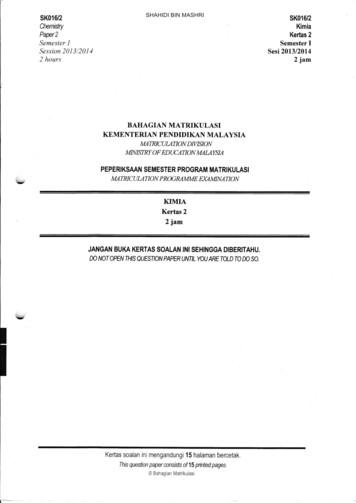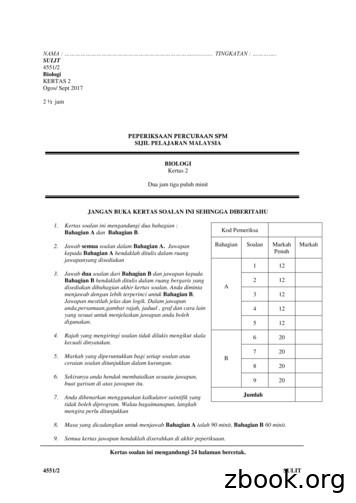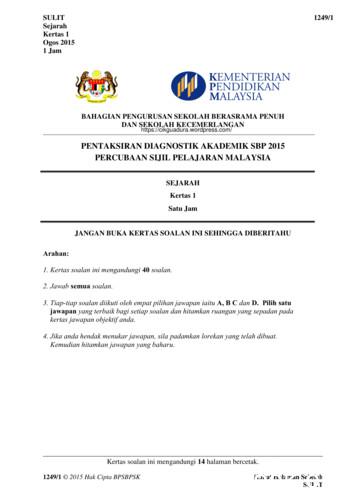SECTION A : 100 MARKS BAHAGIAN A : 100 MARKAH INSTRUCTION .
SECTION A : 100 MARKSBAHAGIAN A : 100 MARKAHINSTRUCTION :This section consists of FOUR (4) essay question. Answer ALL question.ARAHAN :Bahagian ini mengandungi EMPAT (4) soalan esei. Jawab SEMUA soalan.QUESTION 1SOALAN 1(a) Define the following terms :Takrifkan terma-terma berikut :i.Morality / Moralii. Virtues / Kebaikan iii.Etika SosialSocial Ethics /[ 9 marks ][ 9 markah ](b) Define the terms below :Takrifkan terma di bawah ini :i.Consequentialist / Consequentialist ii.Non-consequentialist / Non consequentialist[ 6 marks ][ 6 markah ]
(c) Explain the following consequentialist perspectives :Terangkan perspektif “consequentialist” berikut :i.Egoism / Egoisme ii.Utilitarianism /Utilitarianisme[ 10 marks ][10 markah ]QUESTION 2SOALAN 2(a) Discuss Stakeholder Model with a suitable example.Bincangkan Model Pihak Berkepentingan dengan memberikan satu contohyang bersesuaian.[ 5 marks ][ 5 markah ](b) Identify FOUR (4) impacts to company if they do not adopt CorporateSocial Responsibility.Kenalpasti EMPAT (4) kesan terhadap syarikat jika sekiranya merekatidak melaksanakan tanggungjawab sosial koperat.[ 8 marks ][ 8 markah ]
(c) The goal of corporate culture is to cultivate values, expectations, belief andpatterns of behavior that best and most effectively support ethical decisionmaking, which have become the primary responsibility of corporateleadership to steward this effort. Explain FOUR (4) roles of leadership inestablishing ethical corporate culture.Matlamat budaya koperat adalah untuk menyemai nilai, jangkaan,kepercayaan, serta pola tingkahlaku yang terbaik and mampu menyokongproses pembuatan keputusan secara beretika, ianya menjadi satutanggungjawab utama pemimpin koperat. Jelaskan EMPAT (4) perananpemimpin koperat dalam mewujudkan buya koperat yang beretika.[ 12 marks ][ 12 markah ]QUESTION 3SOALAN 3(a) Explain the concept of employee as an agent to their employer.Jelaskan konsep pekerja adalah agen kepada majikannya.[ 10 marks ][ 10 markah ](b) Identify the issue related to the value of work and employeesresponsibilities in the perspective of ‘self-interest’ and ‘moralobligation’.Kenalpasti isu-isu berkaitan nilai-nilai pekerjaan dan tanggungjawabpekerja dari perspektif ‘kepentingan diri’ dan ‘tanggungjawab moral’.[ 15 marks ][ 15 markah ]
QUESTION 4SOALAN 4(a) Define globalization.Takrifkan globalisasi.[ 3 marks ][ 3 markah ](b) Discuss FOUR (4) ethical issues of globalization.Bincangkan EMPAT (4) isu etika globalisasi.[ 10 marks ][10 markah ](c) Explain SIX (6) universal rights of the ethical responsibilities in internationalbusiness.Terangkan ENAM (6) hak-hak universal dalam perniagaan antarabangsa.[ 12 marks ][ 12 markah ]SOALAN TAMAT
SECTION A : 100 MARKSBAHAGIAN A : 100 MARKAHQUESTION 1 :(a) Define the following terms:i.iii.Morality / Moral ii.Virtues / KebaikanSocial Ethics / Etika Sosial[ 9 marks ]Answer scheme :(i)MoralityPrinciples or rules of moral conduct that people use to decide what isright what is wrong.(ii)VirtuesA virtue is a trait of a person’s character that one should have.(iii)Social EthicsIt raise questions of public policy, law, civic virtue and politicalphilosophy.(b) Define the terms below :(i)Consequentialist / Consequentialist ii.Non-consequentialistNon-consequentialist /[ 6 marks ]Answer Scheme :i.A consequentialist perspective judge the rightness or wrongness of anaction based on the consequences that action has. We choose theactions that bring about the best outcomes.
ii.A non-consequentialist theory of value judges the rightness orwrongness of an action based on the properties intrinsic to the action,not the consequences.(c) Explain the following consequentialist perspective.(i)(ii)Egoism / EgoismeUtilitarianism / Utilitarianisme[ 10 marks ]Answer Scheme :i.Egoism theory is the view that morality coincides with the self-interestof an individual or an organization.Ethical egoism is based on everyone promoting their own individualvalue that is, the right act that maximizes the agent’s value.ii.Utilitarianism means ‘the best action is the action where it can producrthe greatest good for the greatest number of people’.It is the moral theory that we should act in ways that produce the mostpleasure or happiness for the greatest number of people affected by ouractions.QUESTION 2SOALAN 2(a) Identify Stakeholder Model with a suitable example.[ 5 marks ]Answer scheme :-A corporation should be driven by the interest in their stakeholder rather thanthe interest of stakeholder/shareholders alone.
-In addition to earning a profit, this includes consideration of the impact uponmajor stakeholders in decision making.-The stakeholder theory simply acknowledge this fact by requiringmanagement to balance the ethical interest of all affected parties.-This model/theory required the same approach as utilitarianism which focuseson the greatest happiness for the greatest number of people rather than justfocuses on shareholders wealth.-The primary responsibility is to create as much for stakeholders as possible.-Example : any suitable example(b) Determine FOUR (4) impacts to company if they do not adopt a CorporateSocial Responsibility.[ 8 marks ]Answer scheme :-Loss of consumer loyalty in the use of products or servicesLoss profitBad perception by the societyLack of communication between stakeholderLack of government support to the companyAny other relevant answer(c) The goal of corporate culture is to cultivate values, expectations, belief andpatterns of behavior that best and most effectively support ethical decision making,which have become the primary responsibility of corporate leadership to steward thiseffort. Explain FOUR (4) roles of leadership in establishing ethical corporate culture.[ 12 marks ]Answer scheme :-Embrace ethical values in their personal and professional livesInfluence and motivate staff to pay attention to ethics in their daily activitiesRole modelling in establishing practicesReinforce ethical behavior by talking about ethics and emphasize on theimportance of ethics to the organization
QUESTION 3 (a)(a) Explain the concept of employee as an agent to their employee.[ 10 marks ]Answer scheme:The employer is called the principle when engaging someone to act for him. Theperson who does the work for the employer is called the agent. The theory behindrespondent superior is that the principle controls the agent’s behavior and must thenassume some responsibility for the agent’s actions.An employee is an agent for her employer to the extent that the employee isauthorized to act for the employer and is partially entrusted with the employer’sbusiness.The employer controls, or has a right to control, the time, place, and method of doingwork. When the facts show that employer-employee (principal-agent) relationshipexists, the employer can be held responsible for the injuries caused by the employeein the course of employment.In general, employee conduct that bears some relationship work will usually beconsidered within the scope of employment. The question whether an employee wasacting within the scope of employment at the time of the event depends on theparticular facts of the case. A court may consider the employee's job description orassigned duties, the time, place, and purpose of the employee’s act the extent to whichthe employee’s actions confirmed what she was hired to do, and whether such anoccurrence could reasonably have been expected.*Any relevant answer based on examiner discretion can be accepted
QUESTION 3 (b)(b) Identify the issue related to the value of work and employees responsibilities inthe perspective of ‘self-interest’ and ‘moral obligation’.[ 15 marks ]Answer scheme :(i)Self interest :A self interest arises when an employee’s duties and his/herselfinterest collide or are opposed to each other. Ethics encourages allemployees to make personal investment and engage in socialrelations, they shall have any personal or financial interest, whichmight conflict with or influence or appear to influence their judgmentor actions in carrying out their responsibilities.Financial interests in another entity include among others : (ii)Stock or other ownership by the employee, his/her spouse, cohabitant orfinance, or any of his/her relatives by birth or by marriage and/or anyrelated trusts or estates.A brokerage fee, royalty, ownership interest or carried interest in any asset,property, or entity being purchased by or contracted.Moral obligation:All employees are expected to treat their fellow employees withrespect and dignity. Employer prohibits and will not tolerate any formor harassment that creates an intimidating, hostile, or offensive workenvironment including, but not limited to, verbal, visual, religion,age, marital status, veteran status or disability. Such behavior is notonly unethical and in conflict with core values, but may also beillegal.In business should be fair in that they are:Consistent in applying standards across people and over time;unbiased by self-interest; accurate, with the decisions based onreliable information; correctable, in terms of allowing challenge orappeal against decisions; representative of the concerns of allinvolved; and ethical.
Employees must be alert of the freedom of association and theeffective recognition of the right to collective bargaining; theelimination of all forms of forced or compulsory labour; the effectiveabolition of child labour; and the elimination of discrimination inrespect of employment and occupation.*Any relevant answer based on examiner discretion can be acceptedQUESTION 4SOALAN 4(a) Define globalization[ 3 marks ]Answer scheme:Is the process of international integration arising from the interchangeof world views, products, ideas, and other aspect of culture.Refers to processes that increase world-wide exchange of nationaland cultural resources.(b) Discuss FOUR (4) ethical issues of globalization.[ 10 marks ]Answer scheme:The most common ethical issues:-Child labour-Sweat shop-‘ Race to the bottom ’-Employment practices-Human rights-Environment regulations-Corruption / Bribes-Moral obligation of multinational corporations
(d) Explain SIX (6) universal rights of the ethical responsibilities in internationalbusiness.[ 12 marks ]Answer scheme :1. The right to freedom of physical movement2. The right to ownership of property3. The right to freedom from torture4. The right to a fair trial5. The right to non-discrimination6. The right to physical security7. The right to freedom of speech and association8. The right to minimal education9. The right to political participant10. The right to subsistence
BAHAGIAN A : 100 MARKAH INSTRUCTION : This section consists of FOUR (4) essay question. Answer ALL question. ARAHAN : Bahagian ini mengandungi EMPAT (4) soalan esei. Jawab SEMUA soalan. QUESTION 1 SOALAN 1 (a) Define the following terms : Takrifkan terma-terma berikut : i. Morality / Moral ii. Virtues / Kebaikan iii. Social Ethics / Etika Sosial
sK0r6,2 ARAHAN KEPADA CALON: Kertas soalan ini mengandungi Bahagian A dan Bahagian B' Jawab semua soalan dalam Bahagian A dan mf,tra-mana dua soalan dalam Bahagian B' Hanya dua jawapan pertama di Bahagian B akan diperiksa' Jawapan kepada kedua-dua bahagian ini hendaklah ditulis pada buku jawapan yang disediakan. Gunakan muka surat baru bagi nombor soalan yangberbeza'
Kertas soalan ini mengandungi dua bahagian: Bahagian A dan Bahagian B. 2. Jawab semua soalan. 3. Anda dinasihati supaya mengambil masa . 45. minit untuk menjawab soalan . Bahagian A. dan . 50. minit untuk . Bahagian B. Instructions . 1. This question paper consists of two sections: Section A and Section B . 2. Answer all questions.
Bahagian A dan Bahagian B. 2. Jawab semua bahagian.Bahagian A mengandungi 20 soalan. Jawab setiap soalan dengan menghitamkan ruangan yang betul di halaman 9 dalam kertas soalan ini. 3. Bahagian B mengandungi 20 soalan. Jawab semua soalan. Jawapan anda hendaklah di tulis pada ruangan jawapan yang disediakan dalam kertas soalan ini. 4.
2. Jawab semua soalan dalam Bahagian A. Jawapan kepada Bahagian A hendaklah ditulis dalam ruang jawapanyang disediakan 3. Jawab dua soalan dari Bahagian B dan jawapan kepada Bahagian B hendaklah ditulis dalam ruang bergaris yang disediakan dibahagian akhir kertas soalan. Anda diminta menjawab dengan lebih terperinci untuk Bahagian B,
Kertas ini mengandungi DUA (2) bahagian. 4. Jawab SEMUA soalan dalam BAHAGIAN A. 5. Jawab SEMUA soalan dalam BAHAGIAN B. 6. Pastikan semua jawapan soalan-soalan dijawab di dalam kotak jawapan (BAHAGIAN A) dan di ruang kosong (BAHAGIAN B) yang disediakan. 7. Buku sifir dan mesin hitung TIDAK BOLEH digunakan.
Jawab semua soalan di Bahagian A dan tiga soalan daripada Bahagian B. 4. Jawapan bagi Bahagian A hendaklah ditulis pada ruang yang disediakan dalam kertas soalan. 5. Jawapan bagi Bahagian B hendaklah ditulis dalam kertas jawapan. 6. Ceraikan Bahagian B daripada kertas soalan ini. Ikat kertas jawapan bersama-sama kertas soalan ini
MODUL PENINGKATAN TINGKATAN 5 TAHUN 2014 MAJLIS PENGETUA SEKOLAH MALAYSIA (KEDAH) MODUL 1 PRINSIP PERAKAUNAN Kertas 2 Dua jam tiga puluh minit JANGAN BUKA KERTAS SOALAN INI SEHINGGA DIBERITAHU 1. Kertas soalan ini mengandungi dua bahagian : Bahagian A dan Bahagian B. 2. Jawab semua soalan dalam Bahagian A dan dua soalan dalam Bahagian B. 3.
TAMBAHAN / PINDAAN Ruang Perkara Muka Surat Bahagian A Pendapatan Berkanun, Jumlah Pendapatan Dan Pendapatan Bercukai 3 Bahagian B Cukai Kena Dibayar / Dibayar Balik Dan Kedudukan Cukai 6 Bahagian C Maklumat Berkaitan Pengiraan Cukai 8 Bahagian D Maklumat Badan Amanah 12 Bahagian E Maklumat Pemegang Amanah 12 .























